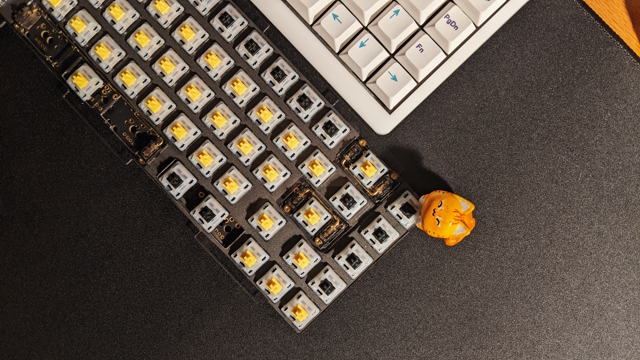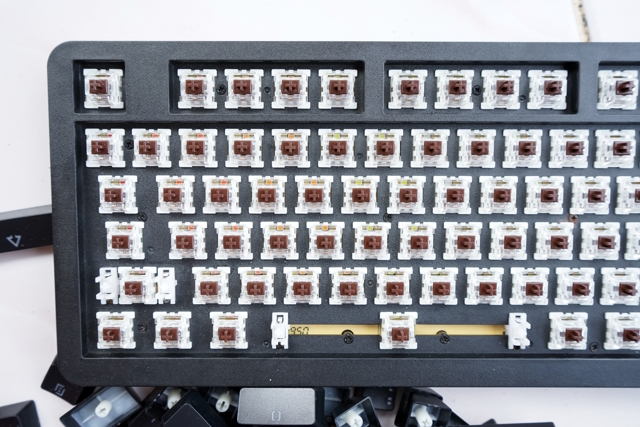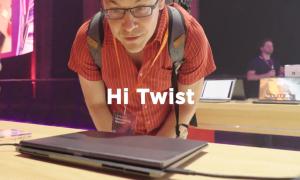The popularity of mechanical keyboards has reached a new high in recent years, and understandably so. They are objectively better than the old, run-of-the-mill membrane keyboards that plague most workstations and home setups. Mechanical keyboards are more reliable, consistent, and durable. Plus, they look prettier and are highly customizable. However, what makes or breaks a mechanical keyboard are its switches. Great switches translate into years of joy, while mediocre ones will leave a bad taste in the mouth (don’t actually taste the switches, please).
With so many different types of mechanical keyboard switches out there, how do you decide which one should you choose? With our help, hopefully. The three main types of mechanical keyboard switches are — Linear, Tactile, and Clicky. However, before we dive into the different types, let’s understand what a key switch is and how it works.
What Is a Switch in Mechanical Keyboards?
Under each key on a mechanical keyboard lies an intricately designed physical mechanism called a switch. It involves the following components:
- Stem: the part of the switch that moves up and down when you press a key. Your keycaps fit right on the top end of the stem.
- Spring: It provides resistance and returns the stem to its original position after a key press. Without the spring, your keys would stay depressed when you press them and not jump back up.
- Metal Contacts (or Leaves): these are responsible for registering keystrokes.
- Housing: the outer shell of the switch that houses all the other components (hence the name).

When you press a key, the legs of the stem move downward (supported by a spring, which offers resistance) and push against the metal contacts inside the switch. After a certain distance, the stem lets the two metal contacts touch each other, which completes the circuit and lets your computer know you have pressed a key.
When you move your finger off the key, the spring helps it return to its original position, which breaks the circuit and lets your computer know you have released the key. Now that you know how a mechanical switch works, it’s time to check out the different options.
Three Types of Mechanical Keyboard Switches
1. Linear Switches

Quick, easy, and smooth — if these are the three things you want from your mechanical keyboard, linear switches will be your jam. These switches get their name because of their linear action. The force required to press down the switch is consistent throughout, and they glide down smoothly.
Linear switches are also generally lighter to press down. Plus, they don’t have a tactile bump or clicky audio feedback (which you will find in the later switches), making them quieter than other options.
If you play competitive games, you will benefit from the fast and consistent keystrokes that linear switches offer. Also, your teammates won’t complain about the keyboard noise when you type something in the chat during an online game. If gaming is your primary use case, you may want to check out linear speed switches from manufacturers like Cherry and Kailh.
A linear switch mechanical keyboard is also ideal for work/office use, especially if you have an open-plan office setting. All Linear switches have quieter keystrokes, which ensure you don’t get called into the HR office often or get rebuked by your co-workers.
Most budget linear switch mechanical keyboards feature red switches from Gateron, Kailh, or Outemu. They’re a solid place to start if you’re buying your first mechanical keyboard. However, if you’re seasoned and want to kick things up a notch (and have a hot-swappable keyboard), consider giving these switches a shot:
- Gateron Yellows — Fantastic for the money
- Gateron Ink Blacks — Expensive, but ultra smooth
- Cherry MX Black — The tried and tested durable option
- Cherry MX Speed Silver — Very light, great for gaming
- KTT Strawberry — Super smooth and come pre-lubed
The above are just some personal recommendations. Feel free to try other linear options on the market if they tickle your fancy. There are a large number of linear switch options out there.
2. Tactile Switches

Well, the name says it all. Press down on a tactile switch, and you will immediately notice a tiny bump midway through, along with a satisfying (and relatively silent) click. They are springy and offer great feedback, making them a joy to type on.
If you’re buying your first-ever mechanical keyboard, getting one with tactile switches is a safe bet. They’re light, super responsive, and not as loud as clicky keyboards. You can take a brown switch mechanical keyboard to school or work, and it shouldn’t bother the people around you (unless you type like a maniac and smack the keys really hard). They’re also a decent option for gaming.
If you’re considering getting a tactile keyboard, check out options with Brown switches from Cherry or Gateron. They are readily available in most markets and don’t break the bank. However, if you want something fancy, consider the Glorious Panda Switches, Durock T1s, and Boba U4s, all of which are excellent tactile options.
3. Clicky Switches

Ah, these are for the click-clack gang. If you’re a typist who prefers the sound and feel of old typewriters, clicky switches are your cup of tea. They offer a pronounced bump and loud, clicky feedback with each keystroke. While they can be very satisfying to type on (for some folks), they can be annoying for people around you. Only take a clicky-switch keyboard to work if you hate your co-workers.
Try out Cherry MX or Gateron Blues if you’re a regular typist. If you type heavily, consider giving Cherry MX Green switches a shot.
Which Mechanical Keyboard Switch Should You Pick?
If you’re a regular gamer, linear switches may be better suited for you. Their smooth and consistent actuation allows for more precise movements and controls, which can be the difference between winning and losing in a competitive game.
If you type for long hours and want satisfying tactile feedback from the keys, get yourself a tactile (brown) switch keyboard, or if you have an existing keyboard with a hot-swappable PCB, buy tactile switches and swap them in. Also, if you do not want something as smooth as a linear switch or as loud as a clicky switch, go the tactile switch route. They offer the perfect balance between the other switch types and are a fantastic option if you’re only getting started with mechanical keyboards.
If you love the loud sound and feel of old-school mechanical keyboards and typewriters, clicky switches are the way to go! The distinctive clicky feedback you get with each keystroke is very satisfying (maybe not for those around you, but it will be great for you)!
Different switches cater to different crowds, each with its own specific use case. They all sound and feel vastly different, and there’s no such thing as a perfect switch. You can be a heavy gamer who games on a Blue switch keyboard or a typist who smacks down on brown switches for 10 hours a day. It all boils down to your preference, and that’s the beauty (and the entire point) of mechanical keyboards. You can easily personalize every aspect.
Get yourself a hot-swappable mechanical keyboard. It would allow you to sample different types of switches conveniently. See a new switch option that you like? Pull out your old switches and swap the new ones in, and you’re all set! Try out different switches, and there’s a good chance you’ll find one (or more) that suits you best.
OnePlus, in partnership with Keychron, has launched its first-ever mechanical keyboard, the Keyboard 81 Pro. It is a stunning-looking hot-swappable board; one you could go for when it finally hits the market. And welcome to the mechanical keyboards rabbit hole! What’s your favorite mechanical switch? Let us know in the comments down below!


















